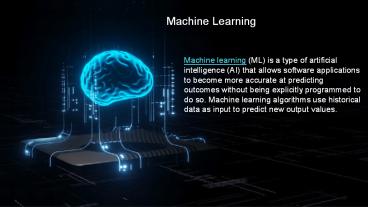Machine Learning - PowerPoint PPT Presentation
Title:
Machine Learning
Description:
machine learning, data scientists supply algorithms with labeled training data and define the variables they want the algorithm to assess for correlations. Both the input and the output of the algorithm is specified. – PowerPoint PPT presentation
Number of Views:857
Title: Machine Learning
1
Machine Learning
Machine learning (ML) is a type of artificial
intelligence (AI) that allows software
applications to become more accurate at
predicting outcomes without being explicitly
programmed to do so. Machine learning algorithms
use historical data as input to predict new
output values.
2
Types of Machine Learning
- Supervised Learnin
- Unsupervised Learning
- Semi-supervised Learning
- Reinforcement Learning
3
- How to use supervised Learning
In this type of machine learning, data scientists
supply algorithms with labeled training data and
define the variables they want the algorithm to
assess for correlations. Both the input and the
output of the algorithm is specified.
4
2. How to use unsupervised Learning
This type of machine learning involves algorithms
that train on unlabeled data. The algorithm scans
through data sets looking for any meaningful
connection. Both the data algorithms train on and
the predictions or recommendations they output
are predetermined.
5
3. How to use semi-supervised Learning
Semi-supervised learning works by data scientists
feeding a small amount of labeled training data
to an algorithm. From this, the algorithm learns
the dimensions of the data set, which it can then
apply to new, unlabeled data. The performance of
algorithms typically improves when they train on
labeled data sets. But labeling data can be
time-consuming and expensive. Semi-supervised
learning strikes a middle ground between the
performance of supervised learning and the
efficiency of unsupervised learning. Some areas
where semi-supervised learning is used include
6
How to use reinforcement Learning works
Reinforcement learning works by programming an
algorithm with a distinct goal and a prescribed
set of rules for accomplishing that goal. Data
scientists also program the algorithm to seek
positive rewards -- which it receives when it
performs an action that is beneficial toward the
ultimate goal -- and avoid punishments -- which
it receives when it performs an action that gets
it farther away from its ultimate goal.
Reinforcement learning is often used in areas
like
7
Use of Machine Learning
Today, machine learning is used in a wide range
of applications. Perhaps one of the most
well-known examples of machine learning in action
is the recommendation engine that powers
Facebook's News Feed.
Facebook uses machine learning to personalize how
each member's feed is delivered. If a member
frequently stops to read a particular group's
posts, the recommendation engine will start to
show more of that group's activity earlier in the
feed.
8
Advantage of Machine Learning
When it comes to advantages, machine learning can
help enterprises understand their customers at a
deeper level. By collecting customer data and
correlating it with behaviors over time, machine
learning algorithms can learn associations and
help teams tailor product development and
marketing initiatives to customer demand.
Machine learning has seen powerful use cases
ranging from predicting customer behavior
constituting the operating system for
self-driving cars. But just because some
industries have seen benefits doesn't mean
machine learning is without its downsides.
9
Disadvantage of Machine Learning
But machine learning comes with disadvantages.
First and foremost, it can be expensive. Machine
learning projects are typically driven by data
scientists, who command high salaries. These
projects also require software infrastructure
that can be high-cost.
There is also the problem of machine learning
bias. Algorithms that trained on data sets that
exclude certain populations or contain errors can
lead to inaccurate models of the world that, at
best, fail and, at worst, are discriminatory.
When an enterprise bases core business processes
on biased models, it can run into regulatory and
reputational harm.
10
Future of Machine Learning
While machine learning algorithms have been
around for decades, they've attained new
popularity as artificial intelligence (AI) has
grown in prominence. Deep learning models, in
particular, power today's most advanced AI
applications.
Machine learning platforms are among enterprise
technology's most competitive realms, with most
major vendors, including Amazon, Google,
Microsoft, IBM and others, racing to sign
customers up for platform services that cover the
spectrum of machine learning activities,
including data collection, data preparation, data
classification, model building, training and
application deployment.
11
Thank You































